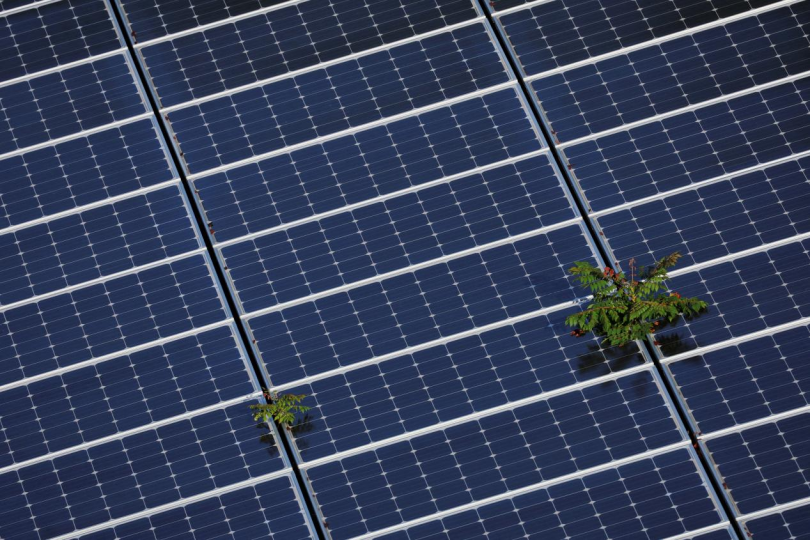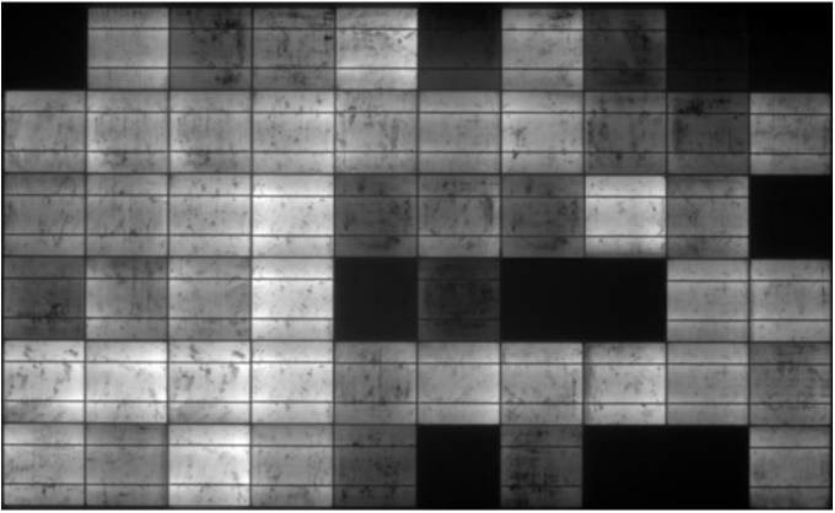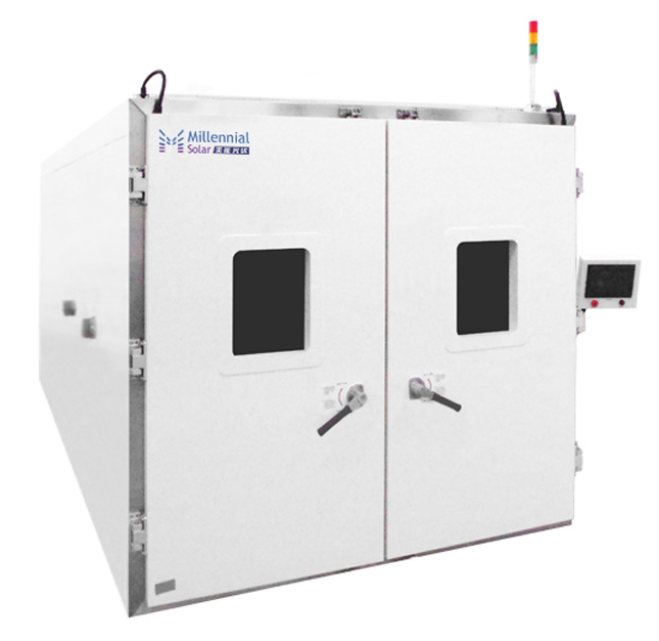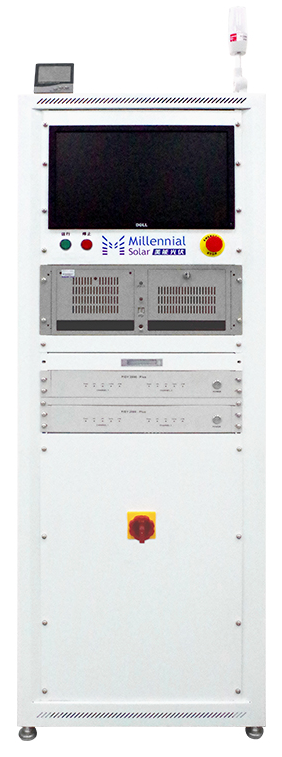
Quantum Efficiency Tester
PL/EL Integrated System
PV-Reflectumeter
3D Confocal Microscope
In-Line Four Point Probe Tester
Four Point Probe Tester
In-Line Thin Film Thickness Tester
Raman Spectrometer
FTIR Spectrometer
Spectrophotometer
Automatic Spectroscopic Ellipsometer
Contact Resistance Tester
Ultra depth of field 3D microscope
Auto Visual Tester
VMM PV Vision Measuring Machine
Solar Cell Horizontal Tensile Tester
Steady State Solar Simulator for Solar Cell
Solar Cell UV Aging Test Chamber
Solar Cell Comprehensive Tensile Tester
Visual Inspection Tester
Wet Leakage Current Tester
PV Module EL Tester
PV Module UV Preconditioning Chamber
Steady State Solar Simulator for PV Module
Current Continuous Monitor
Potential Induced Degradation Test
Bypass Diode Tester
LeTID Test System
Reverse Current Overload Tester
Impulse Voltage Tester
Hipot Insulation Tester
Ground Continuity Tester
Hipot Insulation Ground Tester
Damp Heat Test Chamber
Humidity Freeze Test
Thermal Cycle Test Chamber
Dynamic Mechanical Load Tester
Static Mechanical Load Tester
Hail Impact Tester
Robustness of Termination Tester
Module Breakage Tester
Cut Susceptibility Tester
Peel Shear Strength Tester
Universal Testing Machine (Single-arm)
Universal Testing Machine (Double-arm)
Glass Transmittance Tester
Acetic Acid Test Chamber
EVA Degree of Crosslinking Test System
Junction Box Comprehensive Tester
Drop ball tester
Semi-automatic scanning four-probe tester
Stylus Profilometer
Maximum Power Point Tracker
Perovskite Glass Transmittance Tester
Perovskite P1 Laser Scribing Multifunctional Testing Machine
Perovskite Online PL Tester
Perovskite Online Sheet Resistance Tester
Online Perovskite Film Thickness Tester
Perovskite Process Inspection Workstation
Portable IV Curve Tester
Portable EL Tester
Portable Thermal Imaging Tester
Solar Module Multi-Channel Testing System
PV Inverter Power Quality Tester
Drone EL Tester
IV Tester
IVEL Cell Sorting Machine
How to Avoid the PID Effect of Photovoltaic Modules?
Date : 2023-10-09Views : 140
As the production rate of the photovoltaic module market continues to increase, the quality requirements of solar cells in photovoltaic modules are also increasing with the increase in the production rate. However, because solar panels often deteriorate the passivation of their surfaces due to the PID effect, This results in the attenuation of the module power of the photovoltaic cells. In order to enable module manufacturers to observe this phenomenon more quickly and accurately, "Millennial Solar" launched Millennial Damp Heat Test Chamber, which can efficiently detect the PID effect phenomenon in photovoltaic modules.

![]()
What is the PID effect?
The PID effect is also called the potential induced attenuation phenomenon. When the module is in a negative bias state, under the influence of external factors, leakage current will pass between the solar cell and the metal ground point (usually through the aluminum frame). The packaging material EVA film , backplane, glass, and aluminum frame can easily become leakage current channels. At this time, the sodium ions in the glass will migrate, pass through the packaging material, and then gather on the surface of the solar cell, forming a reverse electric field, causing partial cell failure, which results in a significant attenuation of photovoltaic module power, a phenomenon known as the PID effect.
![]()
How to avoid the PID effect?
The activity of the PID is related to many factors. Among them, the factors that cause the PID effect include the humidity of its photovoltaic modules, the conductivity, acidity and alkalinity of the module surface, and the accumulation of contaminants containing metal ions. In order to better improve the performance of photovoltaic modules, In order to achieve the best performance and efficiency in the application process, the PID effect must be avoided as much as possible. Currently, there are many ways to avoid the PID effect.

● The insulation performance of EVA film can be improved. Currently, EVA film with high resistivity is mainly used as the packaging material, or POE with higher resistivity is used as the packaging material, so as to suppress the PID effect with better performance.
● The PID effect phenomenon can also be avoided by changing the film thickness and refractive index of the ITO film prepared by PECVD.
● In actual applications and research, photovoltaic modules close to the negative pole of the inverter are subject to a relatively high negative bias voltage, and the PID effect will become more obvious; but if the negative output end of the module array is grounded, it can effectively suppress the PID effect.
● Quartz glass without sodium ions can also be used instead of soda-lime glass to suppress the PID effect, but due to the great difficulty in the process, moreover, the cost of quartz glass is relatively expensive, making it impractical to apply it in large quantities in industrial production.
![]()
Millennial Damp Heat Test Chamber

E-mail: market@millennialsolar.cn
During the application process, solar modules will withstand various harsh weather conditions. Among them, the performance of photovoltaic modules such as their ability to withstand high temperatures, high humidity, and long-term moisture penetration needs to be evaluated. DH environmental simulation testing is used to verify and evaluate the reliability of photovoltaic modules or materials and to identify any manufacturing defects early through thermal fatigue-induced failure modes.
● Provide IEC61215 - MQT13; IEC61730 - MST53 solutions
● Temperature fluctuation ±0.5℃, humidity fluctuation up to ±2.0%RH
● Can carry out high and low temperature interactive tests and continue operation
● Maintain ultra-high stability for more than 1000h
● Achieve multi-stage temperature programming, high precision and good reliability
![]()
Millennial Potential Induced Degradation (PID) Tester

E-mail: market@millennialsolar.cn
Millennial Potential Induced Degradation (PID) Tester produced by "Millennial Solar" can be used with Damp Heat Test Chamber to detect power reduction, poor insulation, delamination and other phenomena that occur when solar modules are subjected to harsh environments such as high temperature and humidity and accurately calculate the leakage parameters to determine whether the photovoltaic modules meet the quality standards.
● Can monitor voltage, leakage data, etc. in real time
● The voltage range can reach -2000~2000V, and the voltage accuracy is ±0.5%FS
● Current range is -1000μA~1000μA, current accuracy reaches ±0.5%FS
Even with today's continuous development of photovoltaic module technology, the PID effect still exists. However, with the rapid development of the photovoltaic industry, the PID effect problem will be properly handled in the near future. Damp Heat Test Chamber produced by "Millennial Solar" relies on its excellent testing performance to continuously provide reasonable PID testing solutions to photovoltaic module suppliers and provide customers with efficient services!

































































